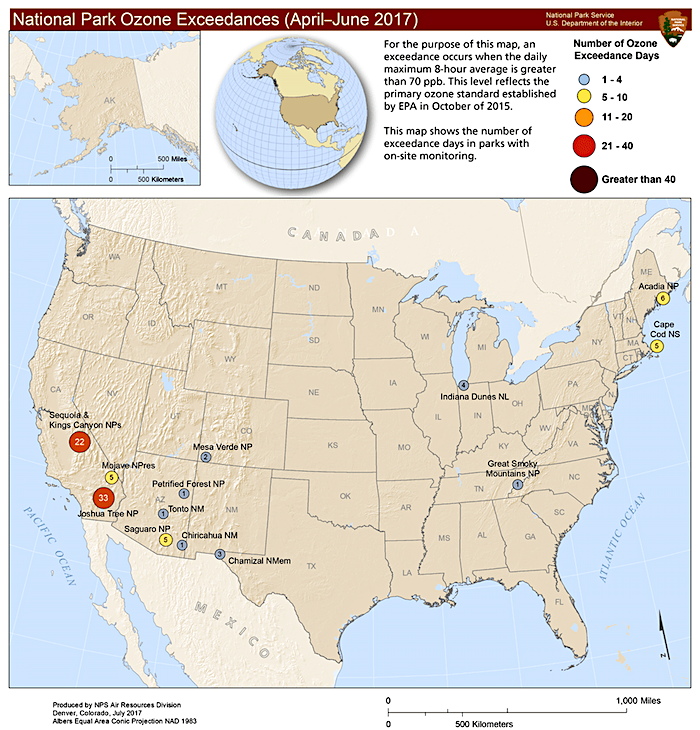
While national parks from Acadia in Maine to Sequoia in California struggle with high ground levels of ozone that are unhealthy, the Trump administration and some members of Congress want to delay regulations that would require states to reduce those levels.
Ozone forms "when pollutants emitted by cars, power plants, industrial boilers, refineries, chemical plants" react with sunlight, according to the Environmental Protection Agency. High levels can exacerabate bronchitis, emphysema, and asthma, particularly among the young and old, people who are exercising, or those who work outdoors.
The Clean Air Act of 2015 set maximum daily exposure to ozone at 70 parts per billion, down from 75 ppb, for an 8-hour average. So far this year Acadia's air quality has exceeded that 70 ppb limit on six days, with the maximum 8-hour average this year peaking at 98 ppb.
In California, meanwhile, Joshua Tree National Park, has exceeded the limit 33 times this year at Black Rock, and 18 days at Cottonwood Canyon, while Sequoia National Park has exceeded it on 22 days. Other parks that have surpassed 70 ppb this year include Chiricahua National Monument in Arizona, Mesa Verde National Park in Colorado, Petrified Forest National Park in Arizona, Saguaro National Park in Arizona, and Tonto National Monument, also in Arizona.
Against these unhealthy levels, Congress is considering legislation to keep the 75 ppb standard in place and delay the more stringent ozone standards established by the Obama administration until 2025.
U.S. Rep. Pete Olson, a Republican from Texas who introduced the House legislation that has 24 cosponsors, told Roll Call, "We want to make sure that common sense is included. With these new rules, you have to take into account jobs and the economy. Right now, they don’t do that.”
EPA Administrator Scott Pruitt last month moved until October 1, 2018, the deadline for implementing the Clean Air Act of 2015 standards.
“Republicans are leading an unprecedented assault on the standards that protect the air we breathe and save thousands of American lives every year,” Jonathan Evans, environmental health legal director at the Center for Biological Diversity, said Monday. “This appalling bill, coupled with other clean-air rollbacks by the Trump EPA, is sentencing thousands of Americans to life-threatening asthma attacks and lung and heart problems.”
Last week a number of groups, including the National Parks Conservation Association, went to court to challenge the delay in implementing the 70 ppb standard.
"EPA itself has found that ozone causes deaths, hospitalizations, asthma attacks, emergency room visits, and other serious harms, and that the existing federal limit on its concentration in the outdoor air is inadequate to protect public health," the lawsuit states. "Yet, in a preemptory action involving no public participation and only cursory explication, EPA recently extended its deadline for promulgating initial area air quality designations for the 2015 national ambient air quality standards for ozone.






Comments
EPA says that Ozone levels up to 100ppb is just fine for all but those unusually sensative to ozone. Seems like 75 ppb would be a reasonable (if not aggressive) standard and even Arcadia never maxed the level considered fine for the vast majority of people. Be interesting what the maxes were at the other "struggling" parks.
https://airnow.gov/index.cfm?action=pubs.aqiguideozone
"We want to make sure that common sense is included. With these new rules, you have to take into account jobs and the economy. Right now, they don't do that."
I sure those words were utttered by many a Chinese official
Yeah, I'm trying to figure out what, exactly, that TX rep meant by taking into account "jobs and the economy". Was he pussyfooting around what he really wanted to say, in that the economy and jobs take precedent over clean air? Seems to me if the air gets bad enough, any sort of jobs or economy geared toward the national parks (at the very least) would suffer, since most visitors sort of expect, more or less, national parks with air and atmosphere far more pristine than, say, Houston or LA or Phoenix. Yeah, I know, Houston's ozone level is considered "good" today, but when I look out of my workplace window and see the slightly yellow-tinged, heavy atmosphere in the distance, it makes me long for the crystal-clear air and bright colors of Mount Rainier National Park that I enjoyed during my most recent visit.
Yes, jobs and economy takes precedent over costly steps that will result in nonconsequential improvements in air quality
There are only a few words necessary to describe the current administration. They include words like GREEDY, DISHONEST, STUPID, UNCARING, CORRUPT.
But I hope we can take a little comfort in understanding that when enough Americans realize how badly we've been screwed over, there will be BIG changes in two and four years when elections roll around. Remember that all the duplicity of the Drumpf years may be undone. It may be difficult, but hopefully damage won't be so great that it will be impossible to reverse.
Your definition of nonconsquential, ecbuck
I'm sure those with poor lung health would disagree with your definition.
Don't forget all the other life that is affected by this decision
When the EPA says 100 ppb is healthy, then moving from 75 to 70 ppb is nonconsequential.
Much better than the first statement